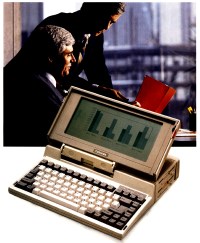Hello, Tosh, gotta Toshiba? There's a good chance you do….

Toshiba UK says it has now sold 10 million PCs in the UK and Ireland, which is almost one in seven of the population, and has published an infographic (below) to commemorate the event. However, the Japanese conglomerate has slipped out of the Top 5 global PC suppliers and its digital divisions -- computers and televisions -- are currently losing money.
Its new chief executive, Hisao Tanaka, says he isn't quitting these markets, but the company is increasing its focus on the rapidly-growing global healthcare market -- driven by aging populations in developed countries such as Japan -- and other areas, including nuclear power. (In the USA, Toshiba owns Westinghouse Electric.)

In the 1980s, Toshiba launched the first mass-market DOS-based laptop with the Toshiba T1100, which I remember well. Not only did I buy one for about £1,000, I still have it. It enabled me to run the XYwrite word processor, which was a PC version of the Atex minicomputer-based system used by many national newspapers, and save stories to a built in floppy drive. While it was heavy at 4.1kg, it was relatively light and compact for its time.
It helped Toshiba establish its place in the portable PC business, and it was the world's leading supplier of laptops from 1994 until early 2002, when it was overtaken by Dell.
Although best known for its Satellite consumer laptops, Toshiba also earned a strong following among what we used to call "road warriors" with its Portégé range. Like the IBM ThinkPad X laptops that were the market leaders, the Portégé's had trackpoint pointing devices and didn't have CD-ROM or DVD drives.
In the 1990s, Toshiba also made an impact with a pioneering subnotebook, the Libretto, which hasn't made the infographic. This provided a full Windows laptop in something about the size of a hardback novel (210 x 115 x 34mm), with a weight of 850-950g. Librettos sold for about a decade, and enabled geeks to carry a whole PC network in their manbags. However, the keyboards were too small to appeal to touch-typists like me.
Today, every major vendor has laptops that are much like the Portégé range -- they are now called Ultrabooks -- which has made the market tougher for Toshiba. And while it did make some very attractive netbooks, that market was killed off by the very limited specifications allowed by Microsoft and Intel, and the withdrawal of the ULCPC (Ultra Low Cost PC) version of Windows XP.
Toshiba has attempted to diversify, without much success. In 2010, it launched its first Google Android-based smartbook, the AC100, and the world's first dual-touchscreen laptop, the Libretto W100. (One touchscreen could be used as a full-sized keyboard, or you could use it like a tablet or a book.) It has also tried its hand at tablets, including the Folio 100, and mobile phones. More recently, it has launched the Kirabook premium range of laptops with 2560 x 1440 PixelPure displays.
As well as dominating the UK market for laptops, Toshiba had a strong position in TV sets and VCRs (videocassette recorders). Many will remember its 1980s TV advertisement, Hello Tosh, Gotta Toshiba, featuring Ian Drury. (It was based on a Top 20 hit song written by the comedian Alexei Sayle, "'Ullo John! Gotta New Motor?")
However, Japanese companies such as Toshiba, Sony and Panasonic have been hit hard by competition from Samsung and other Asian suppliers, and there is no longer a market for VCRs. Toshiba also faces competition from Samsung in other areas where it is strong, such as SSD and hybrid-drive production.
It's not all doom and gloom. In the financial quarter to June 2013, Toshiba's revenues rose by 9.6 percent to Y1.390 trillion ($14.2 billion/£9.2 billion), while operating profits more than doubled to Y24.35 billion. It made a net profit of Y5.30 billion ($54 million/£35 million) compared with a loss of Y12.11 billion in the same quarter last year. It expects to make sales worth Y6 trillion ($61 billion/£40 billion) this financial year.
Hisao Tanaka, who took over as CEO in June, clearly has a lot of re-organizing to do. However, Toshiba remains one of Japan's strongest brands: No 5, according to Brand Directory. A company with its name recognition and breadth of expertise should be able to exploit it, particularly in Asia, Africa and the BRIC countries -- Brazil, Russia, India, and China. That's where the growth is.